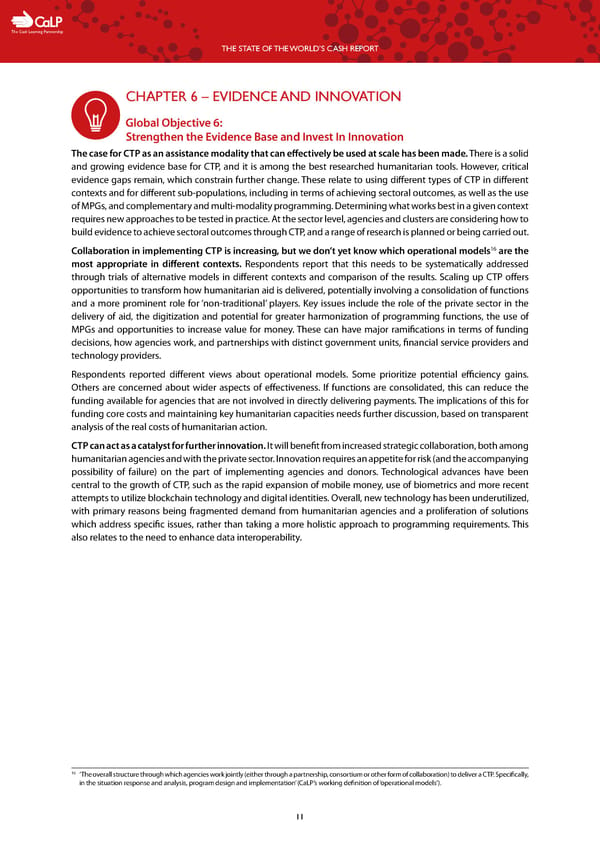C The Cash Learning Partnership THE STATE OF THE WORLD’S CASH REPORT CHAPTER 6 – EVIDENCE AND INNOVATION Global Objective 6: Strengthen the Evidence Base and Invest In Innovation The case for CTP as an assistance modality that can effectively be used at scale has been made. There is a solid and growing evidence base for CTP, and it is among the best researched humanitarian tools. However, critical evidence gaps remain, which constrain further change. These relate to using different types of CTP in different contexts and for different sub-populations, including in terms of achieving sectoral outcomes, as well as the use of MPGs, and complementary and multi-modality programming. Determining what works best in a given context requires new approaches to be tested in practice. At the sector level, agencies and clusters are considering how to build evidence to achieve sectoral outcomes through CTP, and a range of research is planned or being carried out. 16 Collaboration in implementing CTP is increasing, but we don’t yet know which operational models are the most appropriate in different contexts. Respondents report that this needs to be systematically addressed through trials of alternative models in different contexts and comparison of the results. Scaling up CTP offers opportunities to transform how humanitarian aid is delivered, potentially involving a consolidation of functions and a more prominent role for ‘non-traditional’ players. Key issues include the role of the private sector in the delivery of aid, the digitization and potential for greater harmonization of programming functions, the use of MPGs and opportunities to increase value for money. These can have major ramifications in terms of funding decisions, how agencies work, and partnerships with distinct government units, financial service providers and technology providers. Respondents reported different views about operational models. Some prioritize potential efficiency gains. Others are concerned about wider aspects of effectiveness. If functions are consolidated, this can reduce the funding available for agencies that are not involved in directly delivering payments. The implications of this for funding core costs and maintaining key humanitarian capacities needs further discussion, based on transparent analysis of the real costs of humanitarian action. CTP can act as a catalyst for further innovation. It will benefit from increased strategic collaboration, both among humanitarian agencies and with the private sector. Innovation requires an appetite for risk (and the accompanying possibility of failure) on the part of implementing agencies and donors. Technological advances have been central to the growth of CTP, such as the rapid expansion of mobile money, use of biometrics and more recent attempts to utilize blockchain technology and digital identities. Overall, new technology has been underutilized, with primary reasons being fragmented demand from humanitarian agencies and a proliferation of solutions which address specific issues, rather than taking a more holistic approach to programming requirements. This also relates to the need to enhance data interoperability. 16 ‘The overall structure through which agencies work jointly (either through a partnership, consortium or other form of collaboration) to deliver a CTP. Specifically, in the situation response and analysis, program design and implementation’ (CaLP’s working definition of ‘operational models’). 11
 The State of the World's Cash | Full Report Page 12 Page 14
The State of the World's Cash | Full Report Page 12 Page 14